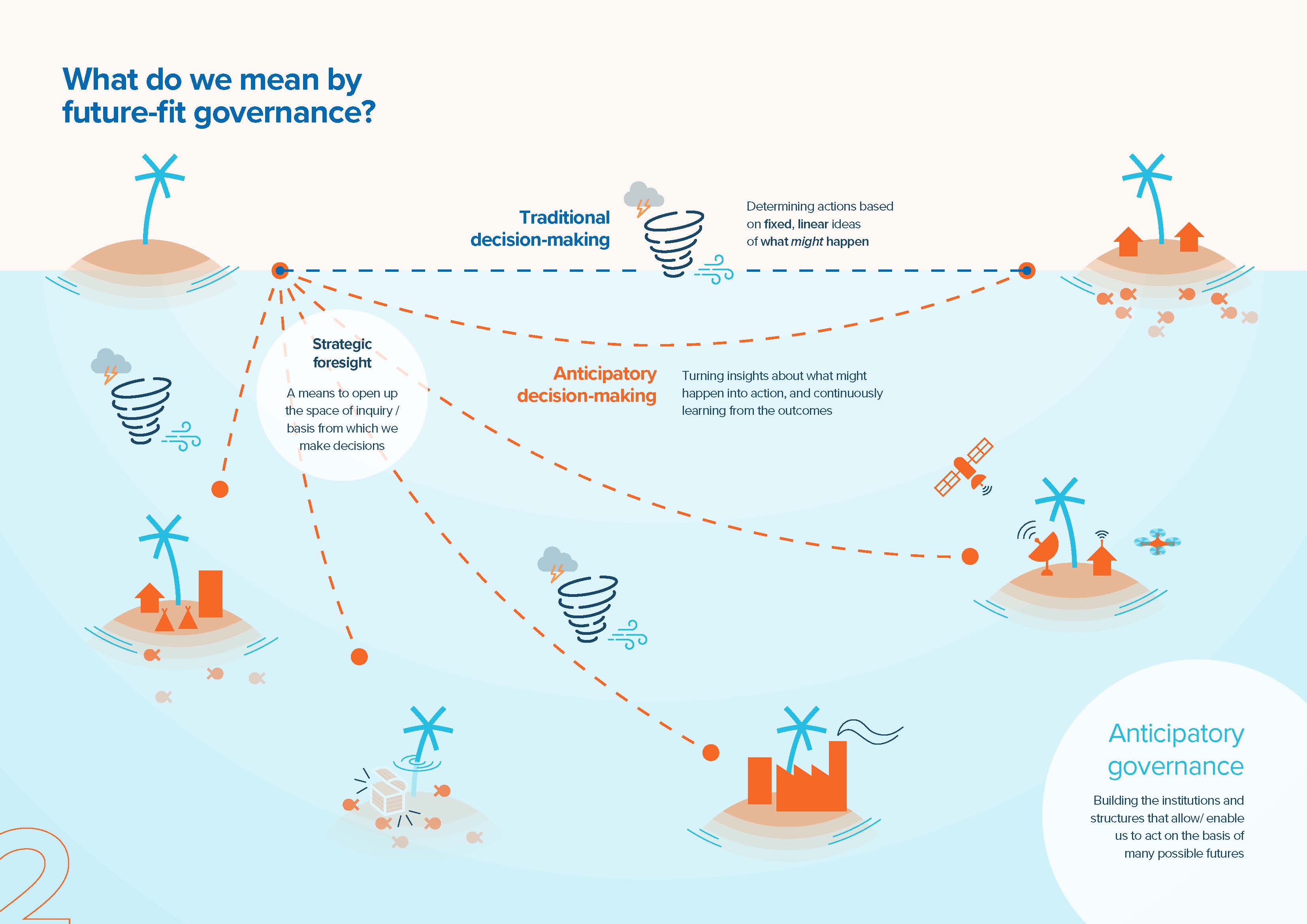Foresight and anticipatory governance: from the eyes of a sceptic
June 28, 2022

Like to know more? Find this infographic and more explained in “Exploring governance models to better prepare and shape futures in the Pacific”.
Do we need to look into the future?
Isn’t looking into something so uncertain and a waste of time? Could we not concentrate on managing the risks we actually know?
Turns out most of what we conceive as random and unknown, is in fact not only known but modelled, predicted and documented somewhere (by human or artificial intelligence). A computer foresaw by who and how COVID-19 vaccines would be created.
Technology can tell us per meter square which areas will be submerged by water in 5, 10 or 20 years. These tools suggest rising seas in the Pacific can be expected to displace one out of three people by 2100.
84 percent of all deaths in Fiji are attributed to non-communicable diseases. Since 2017, the World Health Organization (WHO) has documented best buys – economically savvy ways of saving lives and money from these (mostly) very preventable medical conditions.
Our current political and economic systems are putting the planet on a crash course. Eighty (80) percent of recovery packages during the COVID-19 invested in maintaining the status quo rather than correcting our trajectory.
We gave ourselves 1 year to test what “futurists” had to offer to these existing challenges the Pacific. We wanted to see if their questions allowed us to be more ambitious and if their tools provided answers. 8months on, here is what we still don’t know (and some things we’ve learnt along the way).
So how do we do it?
The most common tools include creating scenarios and back-tracking to the present (scenarios + back-casting), bringing in expert knowledge on emerging trends and things to watch for (foresight) and putting in place systems to regularly check-in on the above and use that knowledge (anticipatory governance and horizon scanning).
And in the Pacific?
Scenarios are a great tool. “Can you describe your best case and worst-case scenario” gets buy in during meetings of high-level decision makers, technical consultations on Non-Communicable Disease, or community budget submissions. The Pacific is three steps ahead of the world when it comes to climate change awareness and doom and gloom scenarios are generally not a challenge (see above). But it is incredibly empowering to visualize a positive “what if” and create the steps that lead to it.
To go beyond a feel-good session during a workshop, it needs some tweaks though. A major effort from the “futures” community to bring their language and methods to the present, the vernacular, ground realities. The first step might be to ask local leaders “how can/should we talk about the future here?”. I’m incredibly grateful for the leadership of civil society thinkers across the Pacific Islands Association of Non-Governmental Organizations (PIANGO) for their patience and willingness to translate our exchanges into their own narratives. It turned out useful. Agreeing on the story of Pacific voices and projecting it into 2050 allowed them to collaborate with the Pacific Internet Society to design the digital tools they need.
That’s why foresight is needed. It is unfair to push back the responsibility of being creative and visionary on people that are struggling to put food on the table every day. (Marginalized and poor communities are amongst the most innovative on earth, but that’s another conversation). Everybody deserves to choose their future, but not on the condition they have to design it from scratch.
Our work with the incredible team of the Vanuatu Ministry of Internal Affairs showed us we have much work to do in analyzing the data and collective intelligence that exists on Pacific Futures. We need to find ways to generate knowledge about opportunities, trends, risks that are relevant to the millions of Pacific contexts without preventing civil servants and communities to complete their most urgent tasks. For instance, in Vanuatu, decentralization reforms that take into account food security, climate change, migration patterns while providing immediate improvements of local services. Reach out if you’d like to be part of that adventure.
What about anticipatory governance? Creating institutions that allow and adapt to changes in the rules of the game and can re-align organically to new information that demands a high level of sophistication and distributed capacity. Some are trying to compensate by creating specific institutions and mechanisms dedicated to representing the interest of future generations, generate strategic foresight, finance longer term projects. A first step might be to enable institutions in the Pacific prevent wasting scarce resources on projects we already know are not part of our future: land that will disappear, outdated technology, unequal and divisive services.
A more ambitious agenda is to design institutions and empower leadership to not only seize opportunities as they arise but purposely choose between alternatives options. Working with the Ministry of Health in Fiji and WHO, we’re reshaping administrations so they can identify the right moment to launch a major effort against high sugar diets, while collaborating with the agriculture sector on food security. It doesn’t look revolutionary – mostly a line in a strategic plan and an additional job in the Wellness department. It might save lives, so we’ll definitely give it a shot.

 Locations
Locations